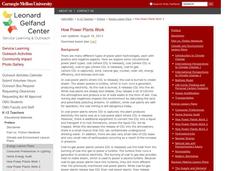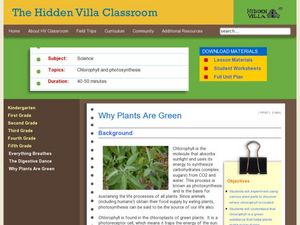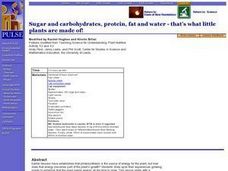Curated OER
Plants: Form and Function
In this plants worksheet, students compare and contrast vascular and non-vascular plants. Students learn the structure and function of the 3 types of plant tissues: dermal, ground, and vascular tissue. This worksheet has 27 fill in the...
Curated OER
Matching Flowers With Their Pollinators
Students match flowers to pollinators and construct models of
flowers to demonstrate why different kinds of flowers need different kinds of
pollinators. They use their flower models and the "Scientific Method Format" included in the...
Biology Junction
Nonvascular and Simple Vascular Plants: Mosses to Ferns
Sometimes conservationists use specific plants to prevent erosion or fight invasive species. A 50-slide presentation covers both nonvascular and vascular plants. It discusses the plants, their stages and life cycles, reproduction, uses,...
Chymist
Batteries
Young scientists study the construction of a battery through experimentation. They engage in five experiments which combine to create a thorough study of the history of batteries beginning with a model of the first battery.
Teach Engineering
The Temperature Effect
How temperature affects the efficiency of a solar panel is the focus of the third in a series of eight resources that presents how engineers are able to control the temperatures of photovoltaic panels. Class members find out how the...
Teach Engineering
Ice, Ice, PV!
Knowing the temperature coefficient allows for the calculation of voltage output at any temperature. Groups conduct an experiment to determine the effects of temperature on the power output of a solar panel. The teams alter the...
Curated OER
Raven Chapter 10 Guided Notes: Photosynthesis
Kim B. Foglia has designed a comprehensive series of AP biology worksheets. This one focuses learners on the progression of photosynthesis in plants. In this assignment, they identify structures and steps on high-quality diagrams, use...
Carnegie Mellon University
How Power Plants Work 3
Double, double toil and trouble, fire burn and cauldron bubble! Find out what drives a turbine to generate electricity and whether or not it has an impact on the environment. A discussion and lecture is divided by a hands-on activity in...
Rice University
Biology for AP® Courses
An eight-unit electronic textbook provides a guide to AP® Biology. Each of the 28 chapters include an introduction, multiple lessons, a summary, review questions, and test prep questions. Teachers see how each lesson connects to a big...
Curated OER
Plants
In this science worksheet, students investigate plants by first reading a paragraph of information. Students then choose a plant, illustrate and write about it.
Curated OER
Photosynthesis Explored
Students observe the production of gas as an effect of photosynthesis. For this biology lesson, students perform an experiment with pondweed and make measurements and predictions about photosynthesis and the plant.
Curated OER
Understanding: Viruses
Students review what they can recall about viruses. They are explained that they are going to work on a project in which they suggest a useful purpose of a virus. Students use print research materials and the Internet to add to their...
Curated OER
Parts of the Flower and Pollination
Students review the parts of the plant and recognize the parts that are important for pollination. In this pollination lesson, students illustrate and label the parts of a flower. Students compare different types of flowers.
Curated OER
Tropism
Learners conduct various experiments on tropism. In this biology lesson, students explain how gravity affects the growth of plant roots. They identify the different types of tropisms.
Curated OER
Parts of the Seed
In this biology worksheet, students read about the parts of plant seeds and look at a seed diagram. They read about the roots, endosperm, embryo, and the process of germination. They answer 8 online multiple choice questions based on the...
Curated OER
Why Plants Are Green
Young scholars discover the properties of chlorophyll in plants. In this plant biology lesson, students conduct an experiment to find where the chlorophyll in the plant is located. Young scholars are split into small groups and study...
Curated OER
DNA Extraction Lab
Students extract DNA and test for its presence from unroasted (raw) wheat germ using a prescribed procedure. They modify the procedure to provide a less expensive, easier method. They also extract DNA from different available plant,...
Curated OER
Thin Layer Chromatography (TLC)
Middle schoolers study flavinoids and how they exist in the plant kingdom. In this pigment instructional activity students complete a lab activity to see how flavinoids move in substances then record their observations.
Curated OER
Feed Me, Seymour
Young scholars work in small groups to create posters illustrating the major facts and functions of plant organs. Within their groups, they assume the role of specialists creating specialized posters pertaining to the different parts of...
Curated OER
What is a Seed?
First graders identify the parts of a seed. In this plant biology lesson, 1st graders are given a seed and identify each part of the seed by using a hand lens. Students plant a seed and graph the growth.
National Institute of Open Schooling
Radioactive Pollution
Radioactive pollutants can enter the body through ingestion, inhalation, absorption, or injection. The last lesson in a series of 36 introduces pupils to radioactive pollution. They study its sources, both natural and man-made, its...
Curated OER
Cellular Cellebrities
Sixth graders, in groups, learn the morphology and function of organelles within plant and animal cells.
Curated OER
Sugar and carbohydrates, protein, fat and water - that's what little plants are made of!
Students identify photosynthesis as the mechanism by which plants convert sunlight energy into a usable energy source for plant processes. They identify photosynthesis as the mechanism by which plants create a molecule that can be used...
Curated OER
Mitosis and Meiosis Exercise
In this cell division worksheet, students answer 15 multiple choice questions about both mitosis and meiosis. Topics include the outcomes of the processes, the phases of the processes and steps within each process.
Other popular searches
- Animal and Plant Cells
- Specialized Plant Cells
- Animal Cells Plant Cells
- Animals and Plant Cells
- Animal & Plant Cells
- Compare Plant Animal Cells
- Animal Plant Cells
- Plant Cells Photosynthesis
- Plant Cells Edible Projects
- Label Plant and Animal Cells
- Plant Animal Cell Diagram
- Plant Cells Organelles

























